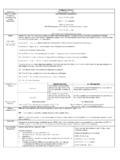Transcription of Bon Secours Richmond - Stellaris Health
1 hyponatremia Algorithm Measured Serum Osmolality Normal (~ 280 mOsm) Isotonic Elevated (> 280 mOsm) Hypertonic Low (<280 mOsm) Hypotonic hyponatremia Pseudohyponatremia Hypertriglyceridemia, hyperglobulinemia Ion-specific electrodes has alleviated this lab error Hyperglycemia Unmeasured effective osmoles (glycine, mannitol, sorbitol, maltose, radiocontrast dyes)Hypovolemic Hypotonic hyponatremia Total body water Total body sodium Effective arterial blood volume low Hypervolemic Hypotonic hyponatremia Total body water Total body sodium Euvolemic Hypotonic hyponatremia (no edema) Total Body Water Total Body Sodium Uosm > 450 mOsm/kg Uosm > 100 mOsm/kgUosm > 100 mOsm/kgInappropriately High Uosm < 100 mOsm/kg Maximally dilute Appropriately low Una < 20 meq/l Una > 20 meq/l UNa < 20 meq/l Maybe > 20 meq/l with diuretic UNa > 20 meq/lUNa < 20 meq/l UNa > 20 meq/l Causes: Extrarenal Losses Vomiting, Diarrhea Third Spacing (burns, pancreatitis), Bowel obstruction, Trauma, Sweating, Causes: Renal Losses Diuretics, Mineralocorticoid deficiency (aldosterone), Salt losing Nephritis, Bicarbonaturia (renal tubular acidiosis, metabolic alkalosis), Cerebral Salt Wasting Syndrome, Ketonuria, Osmotic diuresisCauses.
2 CHF, cirrhosis, nephrotic syndrome, Low effective arterial blood volume (orthostatic changes in HR/BP, hemoconcentration), causes release of ADH and aldosterone Causes: Hypothyroidism (TSH level), Glucocorticoid deficiency (adenocorticotrophin stimulation test); SIADH, Stress, Drugs, Causes: Primary polydipsia (psychogenic polydipsia), Low solute intake (beer potomania syndrome)Treatment: Onset Slow (> 48 hours): Fluid restriction Onset Rapid (<48 hours): 3% NaCl and loop diuretic Optimize treatment of underlying disease; restrict salt and water intake; give loop diuretics Treatment: Onset Slow (>48 hours): NaCl Onset Rapid (<48 hours): May consider 3% NaC l Stop offending medications; restore intravascular volume with NaCl Treatment: Dialysis Go to Severe Euvolemic Hypotonic hyponatremia on Next page Fluid restrict Causes Acute or chronic renal failure Symptomatic Confusion, ataxia, seizures, obtundation, coma, respiratory depression Acute < 48 hours Chronic > 48 hours orUnknown Duration Treatment: 3% Sodium Chloride 1-2 ml/kg/hour until symptoms resolve, then ml/kg/hour Sodium should not increase any faster than 12 meq/L in first 24 hours, or 20 meq/L in the first 48 hours.
3 Stop 3% Sodium Chloride as soon as medical possible. Water restriction, 3% NaCl plusloop diuretic, stop offending medications; hormone replacement If urine mOsm > 300 a loop diuretic may be needed to enhance water excretion The sum of urinary cations (Una + UK) should be less than the concentration of the infused sodium to ensure excretion electrolyte-free water. Treatment 3% Sodium Chloride 1-2 ml/kg/hour, change to water restriction after 10% or 10 meq/l increase in serum sodium or symptoms resolved. Maximum correction of 15 meq/L per day Water restriction, 3% NaCl plus loop diuretic, stop offending medications; hormone replacement Patients with chronic hyponatremia are at a higher risk for severe side effects if serum sodium is corrected too rapidly.
4 The sum of urinary cations (UNa + UK) should be less than the concentration of the infused sodium to ensure excretion of electrolyte-free water. Chronic Rarely < 48 hoursNo immediate correction needed Long Term Management Identify and treat reversible caused Water restriction Furosemide with 2-3 g of sodium chloride per day Demeclocycline, 1200 mg on day one then 300-600 mg bid (avoid if renal or hepatic insufficiency) Urea 15-60 g/day Asymptomatic or mild symptoms (headache, lethargy, dizziness) There is no consensus about the optimal treatment of symptomatic hyponatremia . Correction should be of a sufficient pace and magnitude to reverse the manifestations of hypotonicity, but not so rapid and large as to pose a risk for developing osmotic demyelination.
5 For mild symptoms of hyponatremia , or asymptomatic patients with serum sodium above 125 meq/l, use a conservative approach. (Water restriction less than l/day) If serum sodium continues to decline NaCl may be given to clarify diagnosis. If the patient has SIADH, hyponatremia will worsen and if they are ECF volume contracted serum sodium will improve. Severe EuvolemicHyptonic hyponatremia (Serum Sodium < 125 meq/l)





